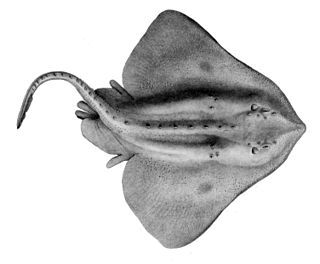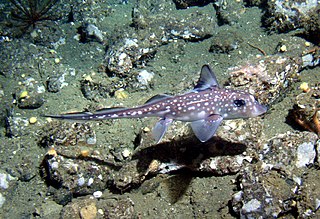
Skates are cartilaginous fish belonging to the family Rajidae in the superorder Batoidea of rays. More than 150 species have been described, in 17 genera. Softnose skates and pygmy skates were previously treated as subfamilies of Rajidae, but are now considered as distinct families. Alternatively, the name "skate" is used to refer to the entire order of Rajiformes.

The angelsharks are a group of sharks in the genus Squatina of the family Squatinidae. They commonly inhabit sandy seabeds close to 150 m (490 ft) in depth. Many species are now classified as critically endangered by the International Union for Conservation of Nature. Once common over large areas of the Northeast Atlantic from Norway, Sweden, Morocco and the Canary Islands, to the Mediterranean and Black Seas, fishing pressure has resulted in significant population decline.

Chimaeras are cartilaginous fish in the order Chimaeriformes, known informally as ghost sharks, rat fish, spookfish, or rabbit fish; the last three names are not to be confused with rattails, Opisthoproctidae, or Siganidae, respectively.

The Australian ghostshark is a cartilaginous fish (Chondrichthyes) belonging to the subclass Holocephali (chimaera). Sharks, rays and skates are the other members of the cartilaginous fish group and are grouped under the subclass Elasmobranchii. Alternative names include elephant shark, makorepe, whitefish, plough-nose chimaera, or elephant fish. It is found off southern Australia, including Tasmania, and south of East Cape and Kaipara Harbour in New Zealand, at depths of 0–200 m (0–656 ft). Despite several of its names, it is not a shark, but a member of a closely related group.

The dark ghostshark is a shortnose chimaera of the family Chimaeridae, found on the continental shelf around the South Island of New Zealand. In June 2018 the New Zealand Department of Conservation classified the dark ghostshark as "Not Threatened" under the New Zealand Threat Classification System.
The pale ghost shark is a shortnose chimaera of the family Chimaeridae. It is endemic to New Zealand waters.

Apristurus is a genus of catsharks, the family Scyliorhinidae, commonly known as the ghost or demon catsharks.

Callorhinchus, the plough-nosed chimaeras or elephantfish, are the only living genus in the family Callorhinchidae. A few extinct genera only known from fossil remains are recognized. Callorhinchus spp. are similar in form and habits to other chimaeras, but are distinguished by the presence of an elongated, flexible, fleshy snout, with a vague resemblance to a ploughshare. They are only found in the oceans of the Southern Hemisphere along the ocean bottom on muddy and sandy substrates. They filter feed, with small shellfish making up the bulk of their diet. The plough-nosed chimaera lays eggs on the ocean floor that hatch at around 8 months. They are currently not a target of conservation efforts; however, they may be susceptible to overfishing and trawling.

Hydrolagus is a genus of fish in the family Chimaeridae found in the Atlantic, Indian and Pacific Oceans.

The purple chimaera or purple ghostshark is a species of fish in the family Chimaeridae found off Japan and Hawaii. Its natural habitat is open seas.

The pointy-nosed blue chimaera, also known as the pointy-nosed blue ratfish, Ray Troll's chimaera or abyssal ghostshark, is a species of deep-sea fish in the family Chimaeridae.

The Chimaeridae, or short-nosed chimaeras, are a family of cartilaginous fish.

Chimaera is the type genus of the cartilaginous fish family Chimaeridae.

Pristiophorus is a genus of sawsharks found in the Pacific, Atlantic and Indian oceans. Members of this genus differ from the Sixgill Sawshark (Pliotrema warreni) in having five gill slits. Their rostral sawteeth lack prominent transverse ridges on the basal ledges, and the large teeth are not posteriorly serrated.
The marbled ghostshark is a chimaera species in the family Chimaeridae, which lives in waters off the eastern coast of Australia.

The whitespot ghost shark is a chimaera species in the family Chimaeridae, which lives in parts of the Galápagos Islands in the southeast Pacific Ocean. It lives in waters with steep slopes and boulders and grows to a total length of around 40–50 cm (16–20 in).
The Galápagos ghostshark is a chimaera species in the family Chimaeridae, likely endemic to the Galápagos Islands. It was discovered by John E. McCosker in 1995 and described in 2006, scientifically named in honor of McCosker. This chimaera has a brown compressed, elongate body. The holotype and paratype of the species, both juvenile females, had a total length of 38.1 centimetres (15.0 in) and 22.7 centimetres (8.9 in), respectively. It lives in rocky habitats close to the sea floor, in waters about 395–510 metres (1,296–1,673 ft) deep. It is listed as least concern on the IUCN Red List.
Hydrolagus erithacus, or Robin's ghostshark, is a species of fish in the family Chimaeridae. It is found in the southeastern Atlantic and southwestern Indian oceans.












